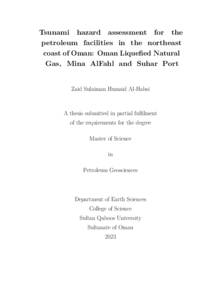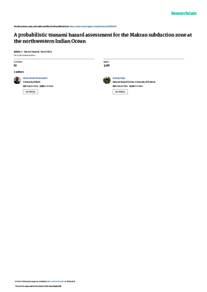Document
Tsunami hazard assessment for the petroleum facilities in the northeast coast of Oman : Oman Liquefied Natural Gas, Mina AlFahl and Suhar port.
Publisher
Sultan Qaboos University.
Gregorian
2023
Language
English
Subject
English abstract
The Sultanate of Oman is considered among the Indian Ocean countries
exposed to destructive tsunamis. This study employs Deterministic
Tsunami Hazard Assessment (DTHA) and Probabilistic Tsunami Haz ard Assessment (PTHA) to investigate the possible tsunamis impact from the Makran Subduction Zone (MSZ) in Oman Sea on three petroleum facility sites
placed on northeastern coast of the Sultanate of Oman, namely Oman Liquefied
Natural Gas (OLNG), Mina AlFahl (MAF) and Suhar Port (SUHP). The DTHA
is a single scenario-based method focuses on estimating the maximum tsunami
impact characteristics. Here, two worst-case earthquake scenarios were selected
from the MSZ: a magnitude 7.2Mw earthquake, west of MSZ, and an 8.8Mw
earthquake scenario, east of MSZ. Plus, an additional 8.1Mw scenario similar to
the historical 1945 tsunami event in Makran.
The PTHA contributes to a large number of possible tsunami sources including
small and large events to quantify the probability of exceeding a specific tsunami
metric threshold values at a given exposure times. Here, a database containing
194 earthquake scenarios was built. In this study, a validated nonlinear shallow
water numerical code is used to simulate the effects of tsunamis for each scenario
over a 5m-resolution grid for each site.
The DTHA results reveal that the OLNG and MAF coastal areas are more
tsunami hazardous than the SUHP site positioned farther north in the coast of the
Sultanate of Oman. The OLNG and MAF sites are exposed to maximum wave
heights in ranges from 2.5 to 4.7 m, causing a maximum runup of about 3.1 m in
OLNG and around 4.7 m in MAF. The maximum inundations in these sites are
not exceeding 100 m in land. On the other hand, due to the SUHP high ground
elevation and the distribution of tsunami energy, the maximum wave height near
its coast is less than 1.7 m, which causes very limited flooding. For precautionary
safety protection measures, a maximum protection elevation limit that goes up to
4 m is introduced for the OLNG and MAF sites, corresponding to 150% safety
factor to the average of the maximum aggregated runups.
The PTHA results for the OLNG and MAF show that the probability that
a tsunami wave exceeds 1 m in height is relatively high. At the OLNG, the
1000-year probability of exceeding 1 m tsunami wave height reaches 70%, whereas
at the MAF it hits 90%. However at the SUHP, this probability is nil on almost
the entire coast. The outcomes of this study show the importance of assessing
the tsunami hazards to develop options to mitigate any future disasters for the
economy, population and environment.
Member of
Resource URL
Category
Theses and Dissertations


